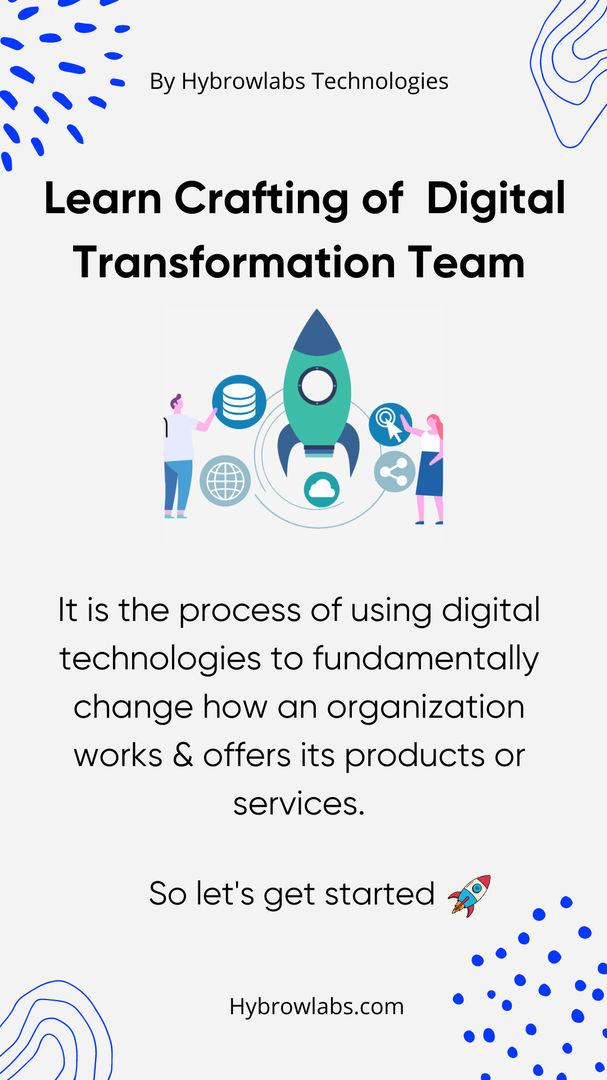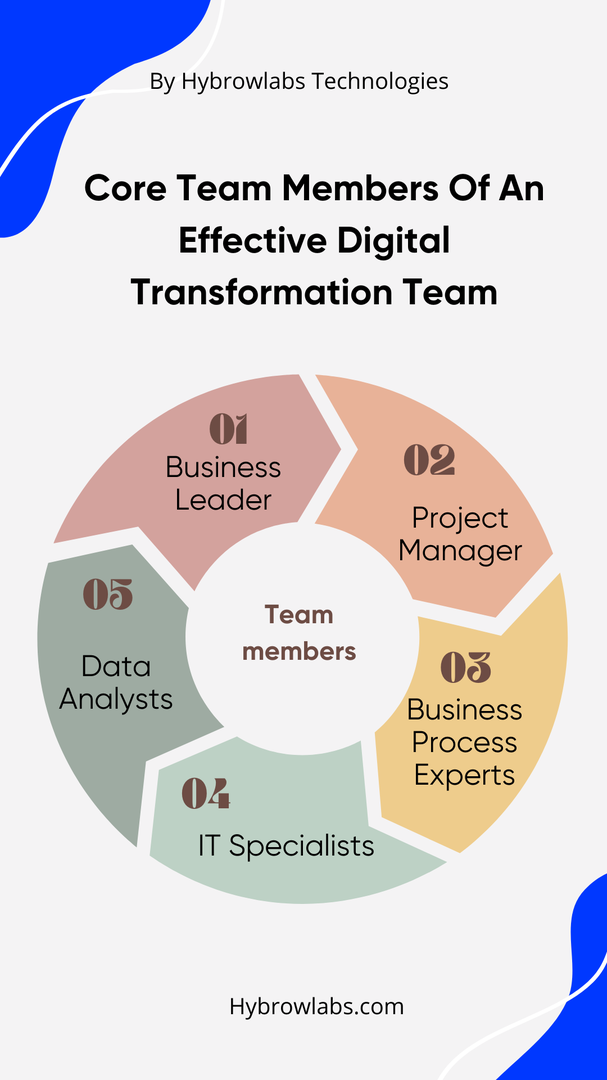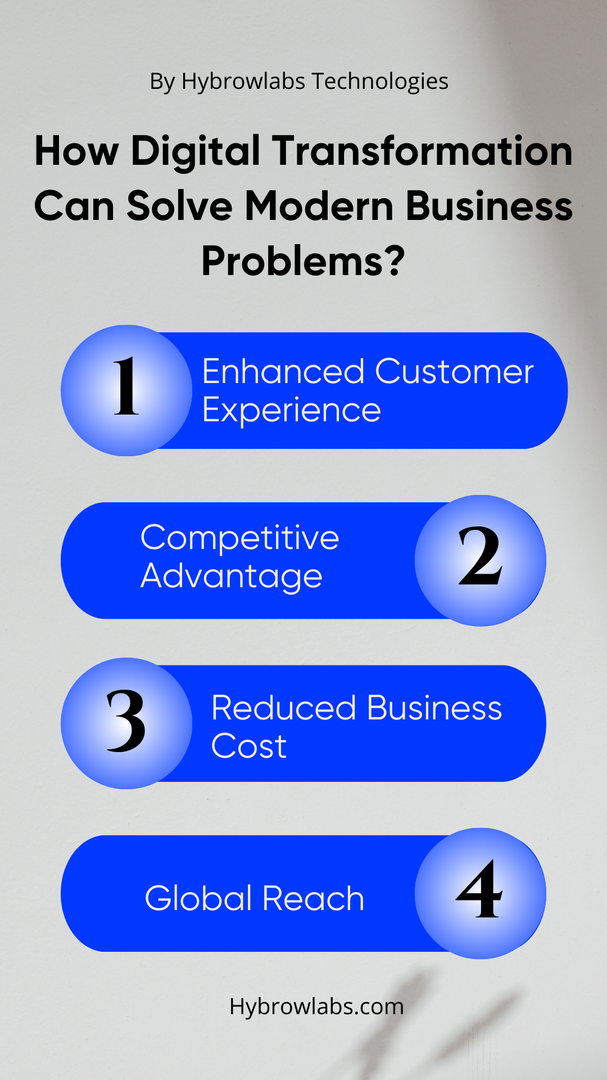
In today's rapidly growing business landscape, digital transformation has become an essential imperative for organizations aiming to stay competitive & relevant. As industries embrace technological advancements & shifting consumer behaviors, the need to adapt, innovate & optimize processes for the digital age has never been more crucial. However, the journey toward successful digital transformation is not solely a technological one; it hinges on the collective actions of skilled professionals who construct the backbone of digital transformation teams. So let’s discuss more effective digital transformation teams. Are you ready with your cup of coffee? Let’s get started!
More Read- Advanced ERPNext: Exploring Frappe V14 Miscellaneous Features
What is Digital Transformation?
Digital transformation is the method of using digital technologies to fundamentally change the way an organization works & offers its products or services. It can involve changes to any factor of the business, from the way products are developed & marketed to the way customers are served.
Core Team Members Of An Effective Digital Transformation Team:

Effective digital transformation teams are important for the success of any digital transformation initiative. These teams should be organized of people with different types of skills & experience, including:
1. Business Leader:
Business leaders play a crucial role in digital transformation teams. They are responsible for setting the vision for digital transformation, confirming that it is aligned with the overall business goals & providing the resources & support that the team requires to be successful.
2. Project Manager:
The project manager is liable for managing the entire digital transformation project, from planning to execution. They need to have strong executive & communication skills, as well as the ability to handle multiple projects simultaneously.
3. Business Process Experts:
Business process experts understand how the organization currently operates & can determine areas where digital transformation can improve efficiency & effectiveness. They need to be able to think very creatively & come up with new ideas for doing things.
4. IT Specialists:
IT specialists are reliable for executing the technical aspects of the digital transformation project. They need to have a profound understanding of the latest technologies & how they can be used to grow the organization's operations.
5. Data Analysts:
Data analysts collect & analyze data to specify trends & opportunities for improvement. They need to be able to use statistical & analytical tools to make sense of large amounts of data.
6. User Experience (UX) Designers:
UX designers develop user-friendly interfaces for the organization's digital products & services. They ought to have a strong sense of human-computer interaction & be able to design interfaces that are easy to use & understand.
How Digital Transformation Can Solve Modern Business Problems?

1. Enhanced Customer Experience:
Customers are increasingly demanding personalized & suitable experiences & they desire organizations to be able to meet their needs in real-time. Digital transformation can help organizations to deliver these experiences by using digital technologies to gather & analyze data, personalize interactions & automate tasks.
2. Competitive Advantage:
The digital economy has created a more competitive landscape, and organizations must have to find ways to differentiate themselves from their competitors. Digital transformation can help organizations do this by developing new products & services, enhancing their customer experience, & simplifying their operations.
3. Evolving Regulations:
Governments are increasingly regulating the use of digital technologies & organizations need to be obedient to these regulations. Digital transformation can help organizations to comply with regulations by using digital technologies to track & organize data, observe compliance & mitigate risks.
4. Changing Workforce:
The workforce is becoming more mobile & tech-savvy & organizations need to be able to attract & maintain top talent. Digital transformation can help organizations to do this by producing a more flexible & agile work environment, supplying employees with the tools & resources they need to be successful & developing new training programs.
5. Business Cost:
The cost of doing business is rising & organizations need to find ways to decrease costs. Digital transformation can help organizations to do this by automating tasks, streamlining processes & improving efficiency.
6. Global Reach:
Digital platforms enable businesses to expand their reach above traditional boundaries. E-commerce & online marketing make it possible to access a global customer base, opening up new market opportunities.
What are The Key Elements of an Effective Digital Transformational Team?
1. A clear vision and strategy:
A digital transformation team should follow a clear vision & strategy that is aligned with the organization's overall purpose. This vision should be based on an understanding of the organization's current business challenges & opportunities, as well as the latest trends in digital technology.
2. A well-defined roadmap:
The digital transformation roadmap should outline the steps that require to be taken to reach the organization's target. This roadmap should be flexible enough to accommodate changes in the business environment, but it should also supply a clear sense of direction.
3. A committed and empowered team:
A digital transformational team requires a committed & empowered team that is willing to take risks & experiment. The team should have a diverse range of skills & experience & they should be given the freedom to innovate new ideas.
4. The right technology:
A digital transformational team requires the right technology. The organization needs to invest in the right tools & platforms to support its digital transformation initiatives to grow relentlessly.
5. A focus on data and analytics:
A digital transformational team is data-driven. The organization needs to collect & analyze data to understand its customers, operations & markets. This data can be used to make better decisions & improve the organization's performance.
6. A culture of change:
A digital transformational team always requires a culture of change. The organization needs to be willing to welcome new ways & ideas of working. This culture of change should be driven by a sense of urgency & a belief in the possible benefits of digital transformation.
Crafting The Optimal Project Structure Of An Effective Digital Transformational Team:

A. Project Initiation and Planning
a)Defining project objectives and goals:
- Clearly outline the desired outcomes & benefits of the digital transformation.
- Align project goals with the organization's overall strategic vision.
b) Identifying stakeholders and their roles:
- Identify all relevant stakeholders, both internal & external.
- Define their roles, responsibilities & levels of involvement in the project.
c) Establishing clear communication channels:
- Determine how the information will flow within the team and to stakeholders.
- Establish regular communication mechanisms like meetings, reports & dashboards.
B. Team Composition and Roles
a) Defining responsibilities of core team members:
- Clearly define roles & responsibilities for each core team member.
- Ensure that each member understands their contribution to the project's success.
b) Cross-functional team collaboration strategies:
- Promote collaboration & information sharing among team members with diverse expertise.
- Encourage open discussions & brainstorming sessions to foster creative problem-solving.
c) Ensuring diversity of skills and perspectives:
- Build a team with a mix of technical, business & creative skills.
- Foster an inclusive environment that values diverse perspectives & experiences.
C. Agile and Iterative Approach
a) Implementing Agile methodologies for flexibility:
- Adopt Agile principles to facilitate adaptability & responsiveness.
- Break down the project into manageable iterations (sprints) for incremental progress.
b) Iterative development and continuous improvement:
- Continuously refine and enhance project deliverables based on feedback & evolving needs.
- Encourage regular retrospectives to identify areas for improvement.
c) Regular review and adaptation of project structure:
- Conduct periodic reviews of the project's progress & alignment with goals.
- Adjust project structure, roles & strategies as needed to address emerging challenges.
D. Scalability and Resource Allocation
a) Adapting team size as project scales:
- Evaluate the team's capacity & expand or contract as the project evolves.
- Ensure that additional team members bring relevant skills & expertise.
b) Allocating resources effectively based on project phases:
- Distribute resources based on project priorities and specific phase requirements.
- Optimize resource allocation to achieve maximum efficiency & value.
c) Leveraging external expertise when needed:
- Identify areas where external consultants, vendors, or partners can provide specialized knowledge.
- Collaborate with external experts to fill skill gaps & accelerate progress.
E. Change Management and Training
a) Identifying change champions and change agents:
- Identify individuals who can champion digital transformation within the organization.
- Empower change agents to promote the benefits & manage resistance.
b) Developing training programs for skill enhancement:
- Provide training & upskilling opportunities for team members to acquire new competencies.
- Equip team members with the skills needed to embrace new technologies & processes.
c) Addressing resistance and fostering a culture of adaptation:
- Anticipate & address resistance to change through effective communication & engagement.
- Cultivate a culture that values continuous learning, experimentation & adaptation.
Here are some additional tips for crafting the optimal project structure for an effective digital transformation team:
- Start with a clear understanding of the organization's goals & objectives. This will help you to identify the right people & resources for the project.
- Be flexible and adaptable. The digital landscape is constantly changing, so it is important to be able to acclimate the project structure as required.
- Communicate effectively with all stakeholders. This will help to ensure that everyone is on the same page & that the project is moving forward smoothly.
- Measure progress & track results. This will help you to identify any areas where the project is falling short & make necessary adjustments.
- Celebrate successes along the way. This will help to keep the team inspired & engaged.
Conclusion:
Digital transformation is not just a destination but an ongoing evolution. It demands an uncompromising dedication to adopting change, harnessing the power of technology & redefining business models to meet the demands of a digital-first world. As businesses venture on this transformative journey, they stand to unlock a realm of opportunities that will shape the future of commerce, innovation & connectivity. Embracing digital transformation today is an investment in a future that promises growth, resilience & an ongoing impact in the global marketplace. Do you want an effective solution for your business with an effective digital transformation team? Partner with Hybrowlabs & witness immense growth in your business. We have trained and expert techies who will take care of your problems & give you inner peace with more growth & opportunities while you are still enjoying your vacation on a beach. Contact us & make this happen.
FAQ:
What is the primary goal of digital transformation?
Digital transformation aims to fundamentally change how businesses operate & interact by leveraging digital technologies to enhance customer experiences, optimize processes & drive invention for sustained growth & competitiveness.
How does digital transformation impact job roles and the workforce?
Digital transformation can lead to shifts in job roles, requiring new skills & competencies. While some traditional roles might evolve or become automatic, new opportunities in areas like data analysis, AI, cybersecurity & digital marketing may emerge.
What are some examples of successful digital transformation initiatives?
Companies like Amazon, Netflix & Starbucks have transformed their industries through digital invention. For instance, Amazon's shift from an online bookstore to a global e-commerce giant demonstrates the impact of digital transformation.
Is digital transformation a one-time process, or is it ongoing?
Digital transformation is an ongoing journey. Technology & customer expectations continue to evolve, requiring organizations to continuously adapt & innovate to stay competitive.
What are the potential risks of digital transformation?
Risks include technological challenges, data breaches, disruption to operations during implementation & the potential for alienating customers if not executed well.



.png)


a3dc85.jpg)

.jpg)
fd8f11.png)

.jpg)
.jpg)